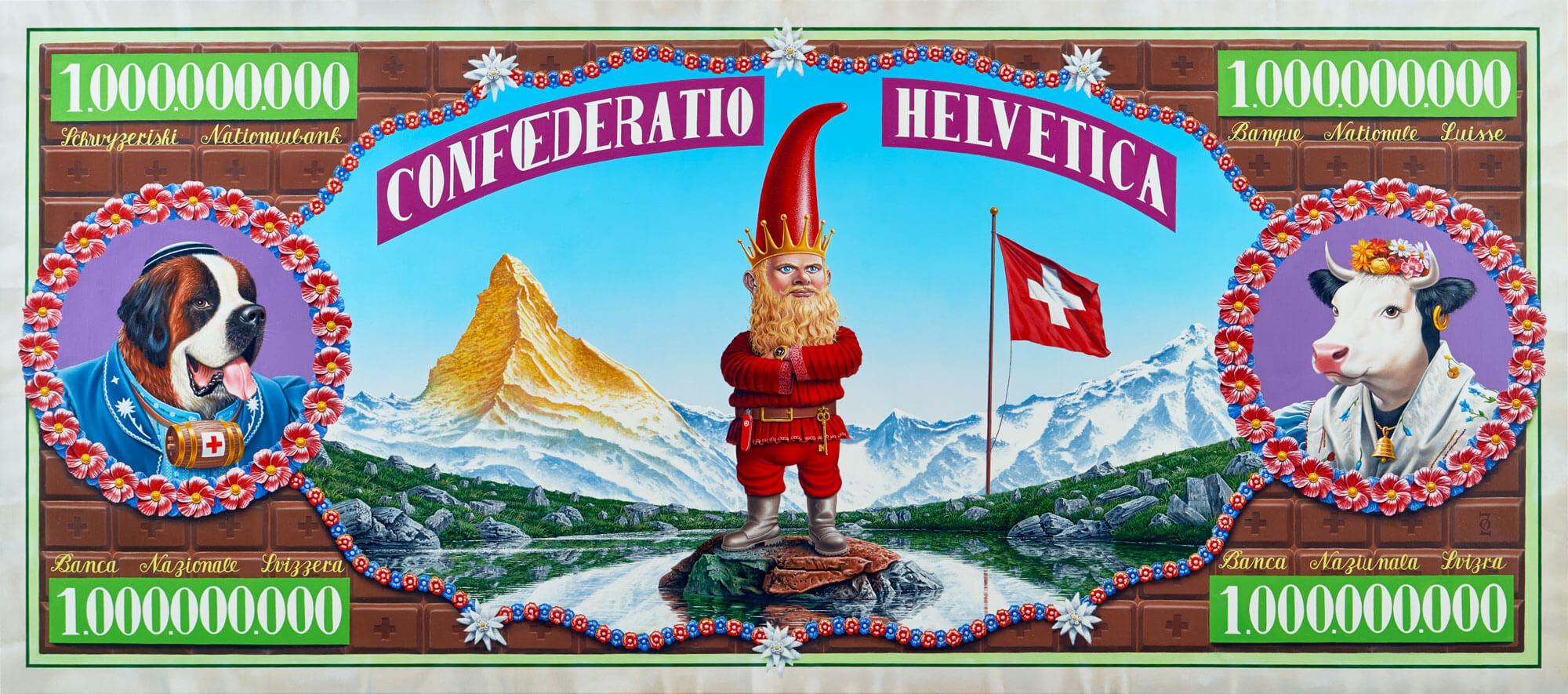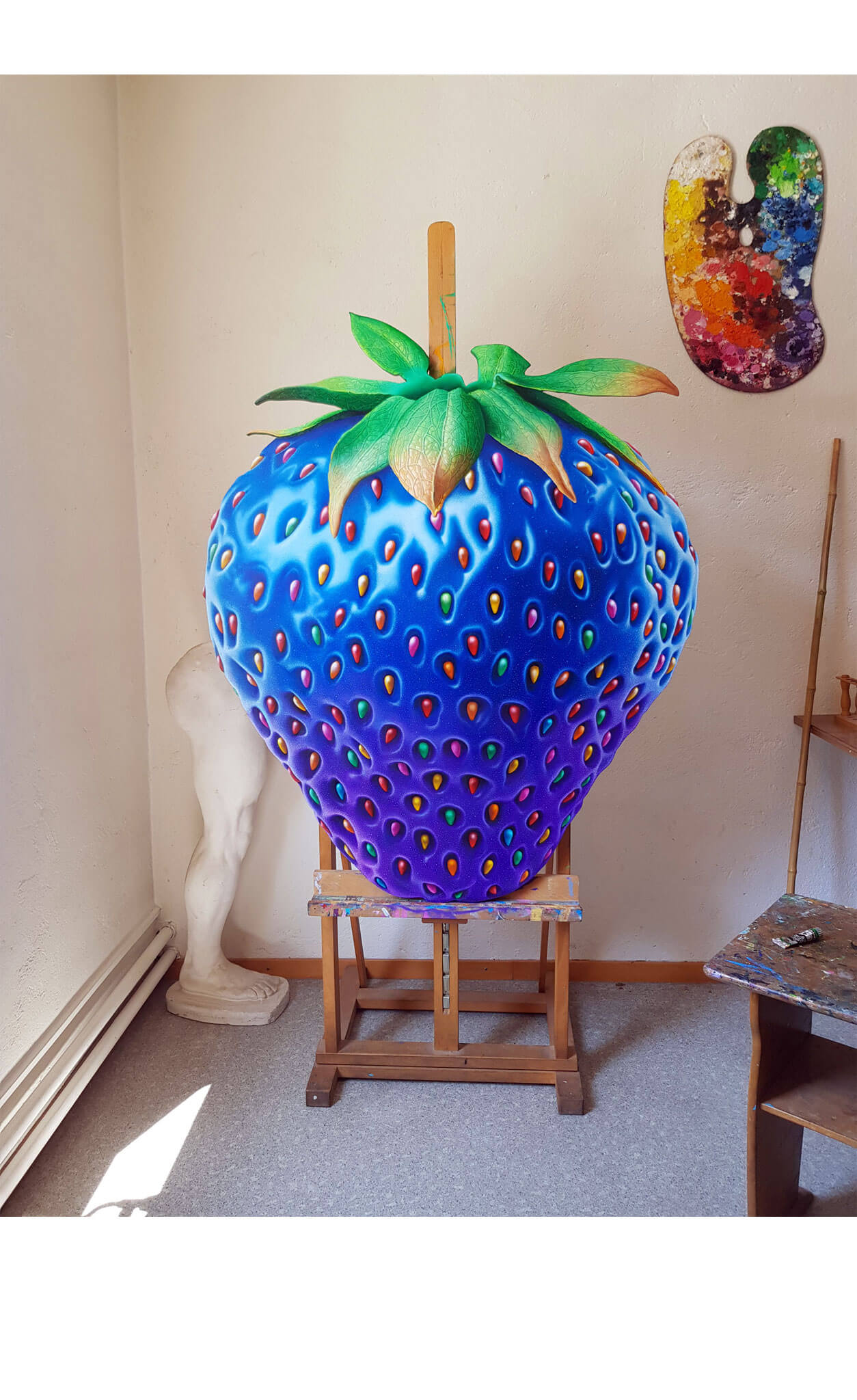Pro Area
Artist Statement
My goal is to make people believe in the reality of my inner vision. Whatever the subject represented or the chosen theme, the approach is always the same: to create the illusion of reality. Photographic realism in oil painting makes the impossible possible, materializes the immaterial, creating the illusion of my subjective reality in the objective reality of the viewer.
The first phase of my approach, from 1994 to 2011, is the exploration of my inner reality, in the fields of imaginary realism, symbolism and surrealism. The goal is to create a world that is as teeming, strange and confusing as possible, while giving it the appearance of reality, through the use of photographic realism. Colour is used in a transgressive way, ignoring the original colour of the subject. This approach allows total freedom in the choice of colours. The second phase of my approach, starting in 2011, goes from imaginary realism to pop art and contemporary art. It nevertheless continues the logic of the first, but by shifting the strange and confusing from the subject to its representation. It is no longer a question of representing a multitude of strange and extraordinary objects, but of representing a single object, banal and common, in a strange and extraordinary way. See the extraordinary in the banal, the strange in the normal, the unique in the multiple.
Pictures / Works
Click to download
Thèmes
Swiss Chocolate
Oil on canvas — 84x200cm — 2021
Swiss chocolate with multiple harmonic symbolism: Diversity of colours in the unity of form. Diversity of flavours in the unity of cocoa. Diversity of cantons in the unity of the constitution. Diversity of origins, races, identities and languages in the unity of nationality. Diversity of power in the unity of decision. Diversity of opinion in the unity of consensus. Diversity of faiths in the unity of the cross.
Edible Flower
Oil on board — 122cm — 2017
A green salad awakens our appetite. But a multicoloured salad confuses our perception, cuts off our appetite and makes us see another reality. The semantic relationship between the object and its natural colour makes us recognize it. This recognition is disturbed when the natural colour is changed.
Organic Strawberry
Oil on wood — 120x120cm — 2019
The strawberry symbolizes our relationship to food. We have moved away from nature to build a sterile and artificial world. Our mind has moved away from our own nature to build a sterile and artificial world of thoughts. Our conception of what is natural is based on our artificial view of life. This is why a strawberry today, however organic it may be, is artificial compared to its ancestor the wild strawberry.
Healthy Food
Oil on wood — 122x125cm — 2019
Man has been manipulating nature for centuries, and today’s food, no matter how organic, is already transformed from its original state. Yet it seems natural to us. In this logic, tomorrow’s food, ever more artificial, will appear natural to its contemporaries. And we will not hesitate to eat a blue hamburger as we find it appetizing.
Nirvana Hamburger
Oil on wood — 200x100cm — 2019
Living in the wild, we found it difficult to find our food by hunting and farming. It was scarce, but natural. Living in an artificial world, we could easily find our food by buying it. It is abundant, but artificial. Abundance and its corollary artificiality are the alpha and the omega of our modern relationship to food.
Good Soup & Tasty Sandwich
Oil on board — 123cm — 2017 | Oil on board — 52x184cm — 2014
Through sexuality, fashion or advertising, the woman’s body is used, consumed and then thrown into oblivion. Barbie’s eternal smile represents a form of unconscious assent that participates in this exploitation.
Fridge Door
Oil on canvas — 81x54cm — 2012
A fridge door is something that we open twenty times a day without looking at it, busy as we are contemplating the inside of the fridge. At first glance, the surrealist irruption of incongruous elements does not change the appearance of this door, but transforms a banal and functional object into a world of fantasy and mystery.
Bang!
Oil on canvas — 184x184cm — 2014
The surprise gift possesses high centrifugal and centripetal force at a high degree of intensity.At first, its visible container is so dazzlingly beautiful that it makes us forget its contents. In a second time, its invisible content is so mysterious that it makes us forget its container, which is torn and thrown into oblivion, even though its content could be disappointing compared to its container.
Made in China
Oil on canvas — 100cm — 2011
Made in China represents the China of dragons, mandarins and the Forbidden City, converted into mass industrial power. The Chinese dragon, dead, in a can, reproduced in billions of copies, is the fallen memory of ancient China in modern China.
Unidentifiable Object
Oil on canvas — 100cm — 2013
A non-identifiable object should not be confused with an unidentified object. In the first case, it is impossible to define the object, in the other it is the opposite. A nipple, or a button, or a pig, or a balloon, or all of these at once, make an non-identifiable object. It is not a question of asking what the object is in reality, but of accepting the reality of the object without asking what it is.
Confœderatio Helvetica
Oil on canvas — 100x230cm — 2015
A country issuing a billion bill is a ruined country. When its development comes to a halt, it withdraws into itself, reverting by force of circumstance to its fundamentals and its natural resources, if any. The dwarf represents the Swiss. He lives on a heap of gold and cuts precious stones. He jealously guards his treasures and the key to his safe never leaves him. He does not like to be disturbed and lets it be known promptly. King on his mountain, he watches over his loneliness fiercely.
One Million Dollars Banknote
Oil on canvas — 100x230cm — 2010
If the United States of America were to issue a million dollar note, it would be the sign of their ruin. The American dream of freedom, prosperity and enjoyment is symbolised by the piggy bank in the middle of a party, in an abundance of food and streamers. The dream, like soap bubbles, always fades away eventually. And the desire for enjoyment remains alone, hungry and pointless, like a solitary denture, which is made to eat but cannot.
One Cent (“E Pluribus Unum”)
oil on board — 30cm — 2018
E pluribus unum is a motto that paradoxically applies to the United States of America. The people are filled by a strong patriotic sense of a unique identity that truly makes them: “One from many”. But individualism possesses this same people and irremediably divides it: individual against individual, individual against community, opinion against opinion, race against race, and reverses the motto: “Many from one”.
Technique
The technique used for the first phase of my production is classic: traditional oil painting on linen canvas or wood panel.
The technique used for the second phase is the same as the one used for the first one: traditional oil painting on wood panel. The difference is that the wooden support is cut by hand to the exact shape of the original object in order to create a trompe l’oeil effect. The curved panel is sanded, treated and then covered with a plaster-based coating.
The drawing, made on tracing paper from the photograph of the object, is then applied to the panel. Then the colours are laid flat, before working on the volume and details.
Videos
The Artist in His Studio
The Artist in His Studio 1:
Working on the details of the pop painting Organic Strawberry
Download (mp4)
The Artist in His Studio 2:
Working on the details of the pop painting Nirvana Hamburger
Download (mp4)
The Artist in His Studio 3:
The beginning of a watercolour
Download (mp4)
Biography
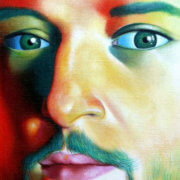
Olivier Zappelli, « OZ », born in Lausanne, Switzerland, on April 1966. In 1990, after hissudies at Fine Art Schcool, he starts a traveller’s life. His first destination is Haïti. There hediscovers voodoo religion as well as the naive and fantastic art of the magic island. Afterthat, he stays in India, where he becomes a sadhu, a shivaistic monk. For several years, hepaints mythological murals in temples throughout north India.
In 1994, during a stay in Norway, he reconnects with oil painting, sinked into oblivion sincethe Fine Art School. In 1996, his art is celebrated by the International Center of Fantastic Art at the Gruyères Castle, Switzerland. There he holds his first solo exhibition. Since 1999, Oz also takes part in group exhibitions in Switzerland, Italy, Spain, France, Germany, Austria, Holland, Denmark and USA.
“OLIVIER ZAPPELLI, HIPPIES, GODDESSES AND GODS”
By Etienne Chatton, Founder of the International Center of Imaginary Realism, Château de Gruyère, Switzerland
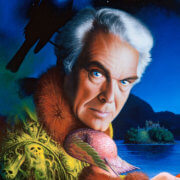
Olivier Zappelli was born in Lausanne on 2 April 1966 at 00:20 am. Aries, ascendant Sagittarius: fire of fire, with the bonus of a fire horse in the Chinese zodiac. A player of extremes, destabilised by any balance, he reveals himself from childhood curious about everything, consumed by desires. On him, the offspring sees converging a picture of ascendants where political passion in the male lineage mixes with a taste for the arts in the female lineage. From an old Piedmontese family, grandfather Zappelli, the socialist deputy mayor of Intra-Verbania, sat in the Roman Senate; after the rise of fascism and the coming to power of Mussolini forced him into exile in Switzerland. On his mother’s side, the Lombards of Neuchâtel are of Cévennes descent. The Desert Museum has honoured the descendants of these exiled Protestants. The neo-classical paintings of great-aunt Jeanne Lombard will be on display alongside those of grandfather Théodore Delachaux and the engravings of great-uncle Aimé Montandon.
In high school, Latin section, the idiom of the ancestors puts the schoolboy in lethargy. A protean dunce, he only wants to scribble while the disciplinary board inflicts the worst violence on him. At the age of sixteen, he was nevertheless entrusted with a comic strip commemorating the 400th anniversary of Collège St-Michel. The work, which is forbidden to be entitled The antics of St Canisius, puts him on probation for a while. His execrable grades, however, forced him to leave the venerable institution two years before the baccalaureate. Exasperated, his father enrolled him at the Beaux-Arts of Sion, where the dazzling illumination of Minimal Art is given in permanent happening, but the beatnik, opting for tag rather than wall tachism, refuses to devote himself to it body and soul.
Olivier Zappelli then enrolled at the Maximilien de Meuron school in Neuchâtel. A hippie in a fur coat and tree mop, he sucks in the joint with the air of the times. By militating for Che Guévara in the ecstasy of piercing, he acquires notions of comparative anatomy as the spirit comes to girls. By copying the friezes of the Parthenon, he still swallows the rudiments of aesthetics and the history of art. But in his third year, he decides to boycott the modelling class; a fanatic of constructivism, the master only dreams of spheres and cubes while Olivier only wants to paint. One stormy day, the dean, showing his authority, throws all his production on the street. An exchange of blows! Expulsion! Back in Fribourg, the future genius decides to punish the impudent despot. He concocts a recipe for dung alcohol which he will serve cold in the time of revenge. Self-taught in the techniques of painting, modelling and tutti quanti, and with his knowledge of elementary chemistry, Olivier decides to play Zap II the return. Having come to pay his respects to the violent headmaster, he sprinkles the hall of honour of the school with liquid nausea, the smell of which will linger for a long time.
In a chaotic search for himself, Brother Olivier enters the Cistercian monastery of Hauterive. The Abbot, eager to test the obedience of the postulant, asks him to give up painting. Two months to macerate out of the shimmering waters of creation before the artist decides to cross the fence. A mystical interlude that a detective would classify as a hit-and-run.
Only tolerated by the official authorities, who sponsor the international competition, non-art leaves many holes in the cheese of the state percentage. Early on in their careers, the elders are into performance. Will Olivier be satisfied with the vaguely anarchist remarks uttered by the revolutionaries in slippers, who advocate an art of destruction? As the son of a bourgeois, who has been feeding on the ears of a judge father and a press correspondent grandfather renowned for his geopolitical chronicles, a Zappelli cannot confine himself to programming the void. If Art is questioned from the order of the world, it is first of all from a world of ideas.
For the man who laughs, horror always has a derisory side. Humour allows one to bear the tragic. The comic strip is the ideal medium for those who are looking for a figurative way out of the usual clichés. The bubbles of the comic strip are manifestos waiting for myths. Richard Corben inspires the younger generation with his irritating heroes. Just like the Rolling Stones, his art combines vulgarity, hatred and sadism in a pleasantly tonic poetics. For Zappelli, the revolution will be hilarious.
Olivier Zappelli’s compositions strike them with the acronym OZ. Dare. A programme: daring to take risks, making it a constant challenge. Oriental idealism has rushed into the breach opened by the pornographic industry; would it go so far as to draw dirty tricks, images of administrative pipes and the introduction of gadgets with dubious hygiene? If he has committed this sin — nothing human is foreign to him — let the critics see in these sins of youth an encouragement to humility.
In the meantime, Olivier Zappelli has joined the post office administration. He stamps letters and lugs parcels. By the time he collects a few dollars, the cicada reopens its wings and flies to Haiti. Animism is the original form of all belief. On All Saints’ Day, the whole island is transformed into a gigantic seance of spiritualism. As a neophyte, OZ takes part in countless voodoo ceremonies. Too intellectual or not enough abandonment, he will never reach the trance of the innocent souls and bodies over which the spirits ride. Besides, this teeming life lacks asceticism. By chance, a book on India brings him enlightenment. Via the airport of Port-au-Prince. Immediate boarding.
From New Delhi, armed with rustic virtues, the adventurer sets off on the roads of India. Hardened by pleasure more than by effort, he tastes the intoxication of solitude and the joy of living to the fullest. In pursuit of his own secrets, he immerses himself in the Ramayana. The hunger for superficial mirages is appeased, the dull boredom of everyday life returns. Although the sweet prattle, woven in garlands around faith, leaves him sceptical, he decides to try the experience of monastic life. In order to conquer a highly tantric mastery, the complete rebel, kicked out of school and the army, submits to all the rules.
Bare-chested and barefoot, the salmon dhoti, the glorious emblem of the itinerant monk, covers the least glorious part of his anatomy. With his beard and hair covered with ashes of cow dung, he begs for his food in the Hindi language. Still addicted to the need to paint, at the temple of Kajuraho, Hanuman Mandir, he receives a mandate to represent the monkey god Hanuman. Complete happiness: a six-metre long fresco that he completed before reaching Bhairotik, Kal Bhairo Mandir, where the monks ordered him to illustrate an episode of the Mahabharata. The amazed villagers come to bow before the sacred images and touch the feet of the venerable sadhou.
From the outset, OZ confines itself to symmetrical compositions. As in oriental music, this classical scheme will serve as the harmonic fundamental; it is the continuous base supporting the melodic discourse, where the sithar embroiders its variations ad infinitum. Often, his painting conceals a duality that takes him from the dark to the light. This vertical stretching is in accordance with the principle of liberation. From saturation to clarity, the spirit is released from its gangue of matter. His technique, which saturates the colour, joins the motto of the expressionist rapins: oil on canvas is oil on fire. The tones, which he superimposes on his canvas in very thin layers, let a vibrant light penetrate under his glazes.
Neither really childish nor really adult, he has kept a torn soul: the innocent Peter Pan in perpetual struggle against the ferocious Dracula. This fawn-like appetite for the brutal efficiency of the poster requires these contrasts between harmony and delirium. The subjects arise spontaneously. He keeps in reserve multiple themes that he neither seeks to analyse nor to censor. He brings them out when a visceral desire imposes their projection. This urgency of the unconstructed idea can only be explained at the end of the journey, when innumerable embellishments have enriched it.
In his canvases, which he exploits in parallel, he manages to interweave contemporary references, mixed with the most rigorous classicism. Opposing the light and the dark, the immense and the derisory, he makes a tiny cartoon cohabit with a giant in the Sistine Chapel. The diversity of these contributions creates tension; they generate intensity. Contestation becomes a source of poetry. Summoned to explain himself, OZ justifies his fascination with the great classics: “Michelangelo for the power he gives off from his bodies, for his bright orange drapes and apple green shadows. Dürer who breaks all taboos. He dared, so I can”.
The little gods who yelp in the darkness demand less convention than truth. By serving dubious masses, OZ only had to mimeograph his mythological borrowings. Foolish with good feelings, Oz could pour out his heart to the point of implosion in his children’s portraits. Taken hostage by good society, he would have honoured the priestesses of the temple. As proselytes, they would have been able to inspire the anarchist with their moralizing vision of the class struggle. So many wretched people have fallen there, who no longer even have the excuse to suffer the pressure of the reactionaries. Left to delirium alone, he remains conscious of the limits of the bullshit that it is good manners to overstep.
The portrait of a woman is like a marriage proposal. Alas, the monks refrain from such requests and if they have the desire to paint, they only honour the Blessed Virgin. OZ completed his novitiate in a monastery of Hindu mystics practising tolerance and love of mankind. The sacred principles of this vocation in pursuit of the divine were to bring him to the summit of liberation. But he renounced all his vows, including the vows of chastity. If he was able to keep his virile attributes, he came out marked by the experience of chastity. Would fatality have caused him to fall back into misogyny, which has always been the rut of Christian monasticism?
The Clinton years dealt the final blow to intolerance. But sexual freedom was tinged with iconoclasm. Not all macho men and women are Muslims. They feign respect, but it is to better practice systematic gutting. Whether literary or plastic, their criticism stigmatises the intrigues and ambitions of the muses of power as much as their shamelessness. In this Mecca of political correctness that the world of women has remained, a puddled has-been thinks she has the right to demand that a painter make the apotheosis of the sinuous blonde? Lucidity often makes men cowardly; macho for fear of appearing complacent, OZ was never cowardly. Thanks to his sponsors for never forcing him to spread sweets on the verge of a diabetes crisis.
Exhibitions
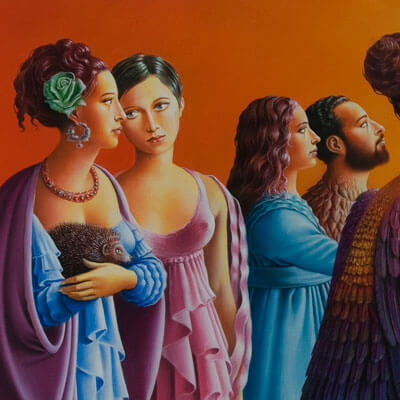
- 2022
-
Incubateur Gallery, Bulle, Switzerland | solo
-
Plexus Art Gallery, Montreux, Switzerland | solo
-
- 2021
- « Pinocchio » Château de Saint-Maurice, Fribourg, Switzerland
- Osmoz Art Gallery, Bulle, Switzerland | solo
- Plexus Art Gallery, Clarens, Switzerland | solo
- 2020
- « Olivier Zappelli » Murten Museum, Murten, Switzerland | solo
- 2019
- « Mémoires vives » Jean Tinguely-Niki de Saint Phalle Museum of Fribourg, Switzerland
- « One million dollars banknote & Exclamations » Carqueville Art Gallery, Gera, Germany
- « Fernisering Lewis Carroll » Langes Magasin, Frederikssund, Denmark
- 2018
- Osmoz Art Gallery, Bulle, Switzerland | solo
- « One million dollars banknote » Circulo del arte, Toledo, Spain
- 2016
- Plexus Art Gallery, Marly, Switzerland | solo
- « One million dollars banknote » Museum im Schafstall, Neuenstadt, Germany
- « Big pieces and intallations » Fässler farm, Belfaux, Switzerland
- « Le Belzé, foyer d’artiste » Fribourg, Switzerland
- Artist club guest of honour, Fribourg, Switzerland
- « The Marsupilami » Saint Maurice castle, Switzerland
- 2015
- « Exclamations ! » San Vicente, Toledo, Spain
- « Angels » and « Exclamations ! » Trierenberg Art, Traun, Austria
- 2014
- « Angels » and « Exclamations ! » Valéry-Larbaud Cultural center, Vichy, France
- 2013
- « One million dollars banknote » Magic realism Museum, Palffy Palace, Vienna, Austria
- « One million dollars banknote » Riegersburg castle, Austria
- « From Bourg to Burg » Spartanburg Museum, USA
- 2012
- Plexus Art Gallery, Clarens, Switzerland | solo
- « Exclamations ! » Exhibition hall, Orleans, France
- « One million dollars banknote » Contemporary Art Gallery, Chamalières, France
- « Exclamations ! » Sedan castle, France
- « Fässler farm 200 years birthday » Belfaux, Switzerland
- 2011
- Plexus Art Gallery, Marly, Switzerland | solo
- « A comme aquarelle » Le Rural, Givisiez, Switzerland
- « Ca déménage chez Plexus » Plexus Art Gallery, fribourg, Switzerland
- « Angels » Riegersburg castle, Austria
- « Angels » Ducal Palace, Nevers, France
- « Exclamations ! » Magic realism art Museum, Palffy Palace, Vienna, Austria
- 2010
- « Shadow and light » Mont-Dore Thermae, France
- « Dreamscapes » Amsterdam, Holland
- « Quadrant fantasy » Fantasmus Art Gallery, Saeby, Denmark
- « Labyrinth to the stars » Amsterdam Whitney Art Gallery, New York, USA
- « Exclamations ! » With Libellule international art group. Jesuit chapel, Chaumont, France
- « Exclamations ! » First magic realism biennale, Alten Rathaus, Viechtach, Germany
- « One million dollars banknote » With Libellule international art group. Grand Palais, Paris, France
- 2009
- Lagrouni Art Gallery, Geneva, Switzerland | solo
- Plexus Art Gallery, Fribourg, Switzerland | solo
- « Angels » Renessans Art Gallery, Florence, Italy
- « Angels » State gallery of modern and contemporary art, Piombino, Italy
- « Miniatures and small masterpieces » Fantasmus Art Gallery, Saeby, denmark
- « Dante and the divine comedy » Fantasmus Art Gallery, Saeby, Denmark
- « Dante and the divine comedy » Alten Rathaus, Viechtach, Germany
- « Angels » Vascoeuil castle, France
- 2008
- « Angels » Ospice St-Charles, Rosny-Sur-Seine, France
- « Dreamscapes » Amsterdam, Holland
- « Angels » Jesuit chapel, Chaumont, France
- « Angels » A L’Ecu de France Art Gallery, Viroflay, France
- « Angels » Alten Rathaus, Viechtach, Germany
- 2007
- « Angels » With Libellule international art group. Usine à Zabu, Saint-Germain-Des-Angles, France
- « Venus and the female intuition » Saeby castle, Denmark
- « Venus and the female intuition » The gouden phoenix Art Gallery, Holland
- « Angels » Sedan castle, France
- « Dreamscapes » RE-ART Art Gallery, Almere, Holland
- « Goldfish » Wekhof, Fribourg, Switzerland
- 2006
- Plexus Art Gallery, Fribourg, Switzerland | solo
- « Fantastic gaze » 16th arrondissement Town hall, Paris, France
- « Karandachoff » Belluard Bollwerk International, Fribourg, Switzerland
- 2005
- « Elemental realms » Agora Gallery, New York, USA
- Omma Gallery, Santa Barbara, USA
- Fri Art Gallery, Fribourg, Switzerland
- 2003
- Boccard castle, Givisiez, Switzerland | solo
- Martiliacus Art Gallery, Marly, Switzerland
- 2002
- « Immagina » Reggio Emilia, Italy
- « Pain, source of creation » Swiss national exhibition 2002, Arteplage of Yverdon-Les-Bains, Switzerland
- 2001
- « Tra sogno e magia » State gallery of modern and contemporary art, Piombino, Italy
- 2000
- « Hundred metamorphosis of woman » International center of fantastic art, Gruyères castle, Switzerland
- 1999
- « Nave of the fools » International center of fantastic art, Gruyères castle, Switzerland
- « Immagina » Reggio Emilia, Italy
- 1996
- International Center of Fantastic Art, Gruyères castle, Switzerland | solo
- 1994
- « Fri-BD » Rue d’Or cave, Fribourg, Switzerland
- 1985
- « Swiss brothers » La Marge Art Gallery, Lausanne, Switzerland
Publications
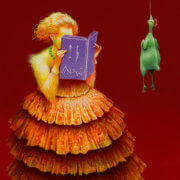
Press articles
- La Liberté, March 2022
- La Liberté, 14 May 2020
- Freiburger Nachrichten, 13 March 2020
- La liberté, 9 May 2019
- La Gruyère, 18 October 2018
- La Liberté, 31 October 2018
- Grand Fribourg, 19 June 2015
- La liberté, 7 April 2007
Magazine articles
- Revue Accrochages, October 2022
- Art Aquisitor, Fall 2010
- Paris Match, May 2019
- Byblos Art, No 1 2008
- Artist Spectrum, November 2007
- Pharts, September 2005
- Artist Spectrum, V13 2004
Books
- « Pinocchio ». Éditions de la Fondation du Château de Saint-Maurice, Switzerland. 2021
- « Galerie de pensées joyeuses », by Marc Boivin. Illustrated by Olivier Zappelli, 137 pages. Faim de Siècle Publishing, Suisse. 2021.
- Marc Boivin : Evangile des idées reçues, 155 pages, Faim de siècle Publishing, Switzerland, 2018
- Marc Boivin and Olivier Zappelli : Planches à ressasser (comic book). published by Fleurs Bleues and Faim de siècle, Switzerland
- Comic book for the centenary of Fribourg University . Editions universitaires de Fribourg, Switzerland, 1989
- Comic book for the 400th anniversary of the Collège St-Michel. Editions St-Michel, Switzerland, 1982
Exhibition catalogues
- 2019
- “Mémoires vives“
Museum of Art & History of Fribourg, Espace Jean Tinguely — Niki de Saint Phalle, Switzerland
- “Mémoires vives“
- 2018
- Imaginaire 10. Editions Brusen, Denmark
- Dreamscapes. Editions Imaginary, Holland
- 2016
- Imaginaire 9. Editions Brusen, Denmark
- 1700 et des poussières. Editions Fleurs Bleues, Switzerland
- 2013
- Imaginaire 6. Editions Brusen, Denmark
- 2011
- Libellule, Renaissance contemporaine. Editions Libellule, France
- Anges exquis. Editions Libellule, France
- Exclamations ! Editions Libellule, France
- Béatrice Guelpa : D’une foi à l’autre. Editions Labor et Fides, Switzerland
- 2010
- Art en Capital : Comparaisons. Editions Casta Diva, France
- Dreamscapes. Editions Imaginary, Holland
- Quadrant Fantasy. Editions Brusen, Denmark
- Exclamations ! Editions Libellule, France
- Imaginaire 3. Editions Brusen, Denmark
- 2009
- Gerhard Habarta : Lexikon der phantastischen künstler. Editions I.F.A.A, Austria
- Dreamscapes. Editions Imaginary, Holland
- Dante and the divine comedy. Editions Brusen, Denmark
- Francesco Ragusa : L’Atelier. Editions Faim de siècle, Switzerland
- Imaginaire 2. Editions Brusen, Denmark
- 2008
- Metamorphosis 2. Edition Beinart, Australia
- Imaginaire 1. Editions Brusen, Denmark
- 2007
- Anges exquis. Editions Libellule, France
- Venus and the female intuition. Editions Salbru, Denmark-Holland
- Dreamscapes. Editions Salbru, Denmark-Holland
- 2006
- Regard fantastique. Editions Safir, France
- 2001
- Immagina. Editions Lalli, Italy
- Tra sogno e magia. Editions Lalli, Italy
- 2000
- Arte Europa. Editions Lalli, Italy
- Bouquet de plumes. Editions La Sarine, Switzerland
- 1993
- Centenaire des SIB. Editions SIB, Switzerlalnd












